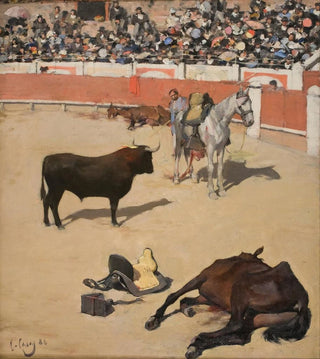Art print | Dead Bulls and Horses - Ramon Casas


View from behind

Frame (optional)
In the vibrant landscape of Catalan art, "Taureaux Chevaux morts" by Ramon Casas stands out for its boldness and emotional depth. This artwork, which transcends simple animal representations, evokes a dialogue between life and death, raw strength and fragility of existence. By immersing oneself in this universe, the viewer is invited to feel the palpable tension emanating from the canvas, where each brushstroke seems to tell a story, a struggle, an inevitable passage. The artist, through his incisive gaze, manages to capture the very essence of his subjects, making this piece a true masterpiece of modern painting.
Style and uniqueness of the work
Ramon Casas's technique in "Taureaux Chevaux morts" is characterized by striking realism, combined with an almost impressionist sensitivity. The colors, both dark and vibrant, create a heavy, almost tangible atmosphere. The forms of the animals, although depicted realistically, seem to transcend their physical nature to become symbols of struggle and sacrifice. The artist skillfully plays with light and shadow, emphasizing the contours of the inanimate bodies while hinting at a certain beauty within tragedy. This contrast between life and death, strength and vulnerability, is at the heart of the piece, inviting the viewer to a deep reflection on the human and animal condition.
The artist and his influence
Ramon Casas, an emblematic figure of Catalan modernism, knew how to mark his era through his artistic and social engagement. Influenced by European movements of his time, he developed a style that is uniquely his own, blending tradition and innovation. His work, rich in colors and emotions, bears witness to a critical view of society of his era, but also shows great sensitivity towards the animal world. Casas surrounded himself with other artists and intellectuals, creating a true circle of exchange that fueled his creativity. Exploring various themes, from daily life to darker subjects, he left an indelible mark on Catalan art, making him a pioneer for future generations.
A wall decoration

Matte finish

View from behind

Frame (optional)
In the vibrant landscape of Catalan art, "Taureaux Chevaux morts" by Ramon Casas stands out for its boldness and emotional depth. This artwork, which transcends simple animal representations, evokes a dialogue between life and death, raw strength and fragility of existence. By immersing oneself in this universe, the viewer is invited to feel the palpable tension emanating from the canvas, where each brushstroke seems to tell a story, a struggle, an inevitable passage. The artist, through his incisive gaze, manages to capture the very essence of his subjects, making this piece a true masterpiece of modern painting.
Style and uniqueness of the work
Ramon Casas's technique in "Taureaux Chevaux morts" is characterized by striking realism, combined with an almost impressionist sensitivity. The colors, both dark and vibrant, create a heavy, almost tangible atmosphere. The forms of the animals, although depicted realistically, seem to transcend their physical nature to become symbols of struggle and sacrifice. The artist skillfully plays with light and shadow, emphasizing the contours of the inanimate bodies while hinting at a certain beauty within tragedy. This contrast between life and death, strength and vulnerability, is at the heart of the piece, inviting the viewer to a deep reflection on the human and animal condition.
The artist and his influence
Ramon Casas, an emblematic figure of Catalan modernism, knew how to mark his era through his artistic and social engagement. Influenced by European movements of his time, he developed a style that is uniquely his own, blending tradition and innovation. His work, rich in colors and emotions, bears witness to a critical view of society of his era, but also shows great sensitivity towards the animal world. Casas surrounded himself with other artists and intellectuals, creating a true circle of exchange that fueled his creativity. Exploring various themes, from daily life to darker subjects, he left an indelible mark on Catalan art, making him a pioneer for future generations.
A wall decoration






